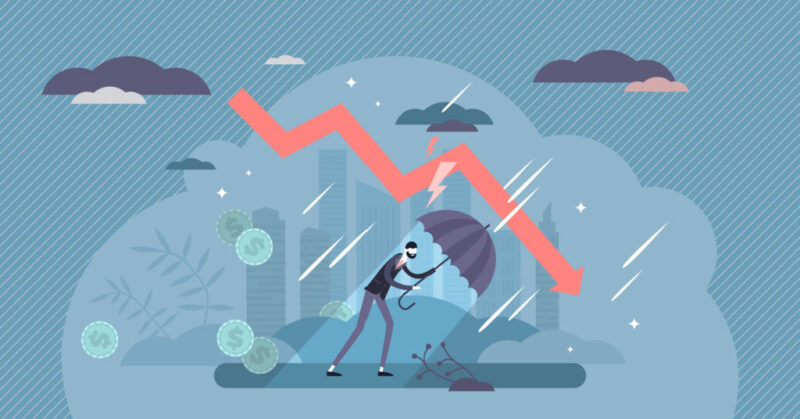When the economy is humming along just fine, in what they call a “Goldilocks economy” (i.e. not too hot, not too cold but just right), politicians and central bankers love to take the credit. Or give it to each other. This can reach embarrassing proportions.
As the late US politician John McCain said about Federal Reserve chairman (1987-2006) and central banking wunderkind Alan Greenspan, “If he’s alive or dead it doesn’t matter. If he’s dead, just prop him up and put some dark glasses on him.”
Just to ensure that there was no misunderstanding, this was meant as a compliment.
Unfortunately for McCain, he said those words in October 2007, just before the narrative of Greenspan’s glorious legacy, known as the Great Moderation, imploded in spectacular fashion…
All of a sudden, the books about Greenspan were getting titled very differently: Who Shot Goldilocks?: How Alan Greenspan Did in Our Jobs, Savings, and Retirement Plans is a memorable example.
Once the crisis broke out, Greenspan ended up getting the blame for inflating the housing bubble which underpinned the Great Moderation. But not from his peers.
It’s in such crises that politicians call out the free market and blame out of control capitalism for crashes. It wasn’t their laws or monetary policy that did the trick, oh no.
Strangely enough, policymakers never connect the two. The idea that forcing a calm creates fragility and eventually causes a storm is beyond them. They just take it one election and appointment at a time, I suppose. In fact, Greenspan was an advocate of the gold standard before being put in charge of the fiat one.
But it’s neither booms nor busts that I want to focus on today. Because those are ordinary. And what we’re facing today is not so ordinary.
Every now and then, something comes along that turns conventional economic wisdom on its head. Hyperinflation and stagflation are two examples.
The idea that prices can soar at thousands of percent does not seem plausible to most people. And yet, it can and does happen. Why we consider it so impossible is the real mystery. It should just be seen as a consequence of certain types of economic policy.
But, more relevant to today is the economic mystery of stagflation. It’s the first of the three bears I want our theoretical Goldilocks economy to meet…
The combination of rising prices and a shrinking economy is a bit of a mystery to the law of supply and demand. The idea that the underlying measure – money – is what’s changing doesn’t ring true at first. It’s like trying to convince someone that their ruler has shrunk.
Of course, prices go up and down all the time. We don’t blame price fluctuations from the seasons on inflation. Nor is inflation a legal defence for monopolistic price gougers. Neither of these have anything to do with the falling value of money. But, for some reason, our energy crisis has been defined as inflation. Let’s not quibble about that… today.
The problem with stagflation is what it does to economic policy. That is because it defies the laws of economics (supply and demand), nobody is quite sure what to do about it.
Should governments stimulate an economy that is shrinking? Or will this only cause more inflation?
Should central banks raise interest rates? It’s not like this solves the problems that are pushing up prices in the first place – the lack of energy for example.
Which brings me to the second bear, or challenge, alongside stagflation. Monetary policy is being forced higher by rising prices. But if this adds cost of living pressures, rather than reducing them, how does that solve the problem?
Sure, mortgage payments aren’t included in inflation statistics directly. But they are part of the cost of living, aren’t they? Unless you stop paying them…
Shifting the cost-of-living pressure to mortgage payments and out of the consumer price index is just the sort of “solution” a policymaker would come up with. When inflation’s a problem, just pay more money to the bank!
It’s a great example of something called Goodhart’s Law – probably the second most important economic law out there, after Bastiat’s “the seen and the unseen” which is better known as the law of unintended consequences.
Goodhart’s Law goes a little something like this: “When a measure becomes a target, it ceases to be a good measure.” Which might be a bit confusing. But, just as Bastiat said about the law of unintended consequences, understanding it might be the whole difference between being a good and a bad economist. So, I beg you to give it some thought. Or just follow along with me a little longer…
When a government announces it will attempt to achieve some sort of target, what’ll actually happen is an undermining of the meaning of the measure that the target is expressed in.
In this case, when the Consumer Price Index becomes a central bank’s measure for inflation, and when it is mandated with a 2% target, the central bank can simply shift spending from inside the CPI basket to outside of it.
Specifically, if slightly cynically, the central bank can raise interest rates to shift spending from food, energy bills and basic necessities, and move it into bankers’ bonuses.
Thus the CPI comes back down, because people can’t afford to buy what they need, and central bankers can declare the inflation problem solved.
Lovely…
… except for the fact that the cost of living itself, which CPI is supposed to represent, is actually still rising.
Thus, the measure that became a target ceased to be a good measure.
But back to our real story of Goldilocks and the three bears.
Right now we have government stimulus spending combining with ever tighter monetary policy. Fiscal and monetary policy are at odds. That is not good.
And so… I give you the third bear.
After decades of fiddling with interest rates and government spending to manage the economy, we’ve reached the obvious endpoint. This is the point in the long run when “we are all dead,” as Keynes would say. That end point is when the policy stops working because of too much debt.
When economies can’t afford piddling interest rate increases and interest rates are not even anywhere near inflation, you know that debt saturation is so high that you’ll need major write-offs to solve the debt problem.
There are two ways to do so. The civilised way involves the International Monetary Fund, as some of us might remember.
The uncivilised way involves inflation, as all Germans are taught to remember. After all, governments print money for a reason. And that reason is to deal with too much debt.
Yesterday we looked into fat tails and instability. Today, I’ve given you what I think are the reasons for why fat tails are on the menu for investors – the three bears of stagflation, tight monetary policy and debt.
What is the optimal investment strategy in an environment that’s so uncertain?
Most who acknowledge these risks advise diversification. Because, during times like this, wealth preservation is the priority.
But find out what Nigel Farage is focusing on here.

Nick Hubble
Editor, Fortune & Freedom



